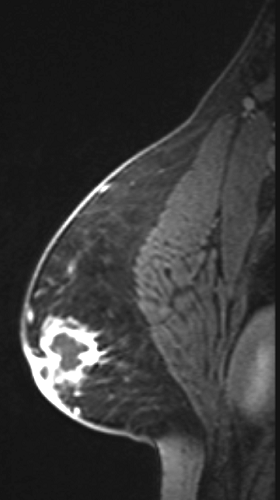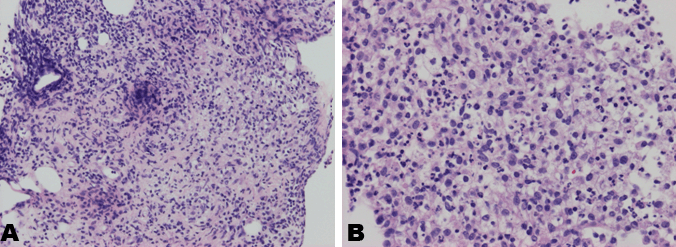
|
 |
|
Case Report
| ||||||
| A case of subareolar abscess in the male breast: Usefulness of magnetic resonance imaging scan for diagnosis | ||||||
| Takaaki Fujii1, Keiko Yanai1, Shoko Tokuda1, Yuko Nakazawa1, Sasagu Kurozumi1, Sayaka Obayashi1, Reina Yajima1, Tomoko Hirakata1, Hiroyuki Kuwano1 | ||||||
|
1Department of General Surgical Science, Graduate School of Medicine, Gunma University, Gunma, Japan
| ||||||
| ||||||
|
[HTML Abstract]
[PDF Full Text]
[Print This Article] [Similar article in Pumed] [Similar article in Google Scholar] 
|
| How to cite this article |
| Fujii T, Yanai K, Tokuda S, Nakazawa Y, Kurozumi S, Obayashi S, Yajima R, Hirakata T, Kuwano H. A case of subareolar abscess in the male breast: Usefulness of magnetic resonance imaging scan for diagnosis. Int J Case Rep Images 2017;8(10):659–662. |
|
ABSTRACT
| ||||||
|
Introduction: Subareolar abscess in the male breast is extremely rare. The main concern with this condition is performing the differential diagnosis, since clinically it often resembles breast cancer. Case Report: A 30-year-old Japanese male presented with pain and swelling of the left breast. Physical examination revealed a 3.0x3.0 cm palpable lump with redness of the skin in the left subareolar region. Magnetic resonance imaging (MRI) scan showed a ring-enhancing mass without wash out with central necrosis below the left nipple, suggesting subareolar abscess. A core needle biopsy was performed, and histological findings revealed granulation tissue with the infiltration of numerous neutrophils, a finding that was compatible with subareolar abscess. Conclusion: Male subareolar abscess is quite a rare disease, however, awareness of how to perform differential diagnosis of subareolar abscess and the use of MRI scan may help in making a definitive diagnosis of subareolar abscess in the male breast and might aid in the proper management of the condition. Keywords: Breast cancer, Male breast, Pain and swelling of present, Subareolar abscess | ||||||
|
INTRODUCTION
| ||||||
|
Benign nonneoplastic entities may occur in the male breast, including intramammary lymph node, sebaceous cyst, diabetic mastopathy hematoma, fat necrosis, and subareolar abscess [1][2]. However, subareolar abscess in known to occur more often in women than men [3], and in males it is extremely rare [1][2][3][4][5]. We herein report a rare case of subareolar abscess in male breast. The main concern with subareolar abscess in male breast is performing the differential diagnosis, since clinically it often resembles breast cancer. In our case, magnetic resonance imaging (MRI) scan was useful for the differential diagnosis between subareolar abscess and malignancy. | ||||||
|
CASE REPORT
| ||||||
|
A 30-year-old Japanese male presented with pain and swelling of the left breast of seven days duration. There was no past history of similar complaints or any other relevant medical history. Physical examination revealed a 3.0x3.0 cm palpable lump with redness of the skin in the left subareolar region (Figure 1). There was no abnormal nipple discharge. Sonography revealed a complex, hypoechoic subareolar mass with a heterogeneous hypoechoic internal echo containing complex fluid and internal vascularity (Figure 2). Magnetic resonance imaging showed a ring-enhancing mass without wash out with central necrosis below the left nipple (Figure 3), suggesting subareolar abscess. A core needle biopsy was performed, and histological findings revealed granulation tissue with the infiltration of numerous neutrophils, a finding that was compatible subareolar abscess (Figure 4). Ultrasound-guided drainage and antibiotic therapy (cefcapene pivoxil) were prescribed. Culture showed the growth of Propionibacterium acnes. The patients required incisional drainage through subareolar incision. No recurrence has been seen for sixteen months. | ||||||
|
| ||||||
| ||||||
| ||||||
| ||||||
|
DISCUSSION
| ||||||
|
We report herein an extremely rare case of subareolar abscess in the male breast. Male subareolar abscess is a localized infection secondary to ductal ectasia, chronic obstruction, and inflammation [1][6]. Smoking is recognized as an aggravation factor, and almost 70% of patients smoked more than 10 cigarettes a day [6][7]. In this case, the patient was a smoker. Common clinical features include pain, nipple swelling, and nipple discharge [1]. On sonography, the abscess usually appears as an incompletely circumscribed mass containing complex fluid (Figure 1). Doppler imaging often shows accentuation of peripheral vascularity with sparse-to-absent internal flow. However, occasionally abscesses may have accentuated internal flow, making the diagnosis of infection less certain and therefore requiring tissue sampling. In our case, core needle biopsy was performed [1]. However, MRI scan may be useful for reaching a differential diagnosis of subareolar abscess. MRI scan revealed a ring-enhancing mass without wash out below the left nipple, which is a characteristic finding in cases of abscess. This case indicates the importance of MRI in differentiating between subareolar abscess and malignancy in the male breast. Familiarity with the features of the male subareolar abscess including MRI findings allows for accurate imaging and make it possible to avoid unnecessary and often invasive treatment. | ||||||
|
CONCLUSION
| ||||||
|
In conclusion, we report here a rare case of subareolar abscess in the male breast. Male subareolar abscess is quite rare; however, awareness of how to perform the differential diagnosis of subareolar abscess and the use of magnetic resonance imaging scan may help in making a definitive diagnosis of subareolar abscess in the male breast and might aid in the proper management of the condition. | ||||||
|
REFERENCES
| ||||||
| ||||||
|
[HTML Abstract]
[PDF Full Text]
|
|
Acknowledgements
We would like to thank Saitoh Y, Yano T, Matsui Y, and Okada S for their secretarial assistance. |
|
Author Contributions
Takaaki Fujii – Substantial contributions to conception and design, Acquisition of data, Drafting the article, Final approval of the version to be published Keiko Yanai – Analysis and interpretation of data, Revising it critically for important intellectual content, Final approval of the version to be published Shoko Tokuda – Analysis and interpretation of data, Revising it critically for important intellectual content, Final approval of the version to be published Yuko Nakazawa – Analysis and interpretation of data, Revising it critically for important intellectual content, Final approval of the version to be published Sasagu Kurozumi – Analysis and interpretation of data, Revising it critically for important intellectual content, Final approval of the version to be published Sayaka Obayashi – Analysis and interpretation of data, Revising it critically for important intellectual content, Final approval of the version to be published Reina Yajima – Analysis and interpretation of data, Revising it critically for important intellectual content, Final approval of the version to be published Tomoko Hirakata – Analysis and interpretation of data, Revising it critically for important intellectual content, Final approval of the version to be published Hiroyuki Kuwano – Analysis and interpretation of data, Revising it critically for important intellectual content, Final approval of the version to be published |
|
Guarantor
The corresponding author is the guarantor of submission. |
|
Source of support
None |
|
Conflict of interest
Authors declare no conflict of interest. |
|
Copyright
© 2017 Takaaki Fujii et al. This article is distributed under the terms of Creative Commons Attribution License which permits unrestricted use, distribution and reproduction in any medium provided the original author(s) and original publisher are properly credited. Please see the copyright policy on the journal website for more information. |
|
|







